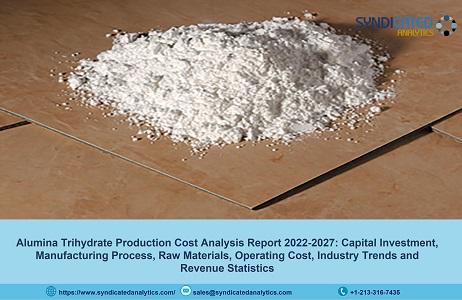Chloroform Plant Cost 2022-2027: Price Trend, Production Cost Analysis and Forecast, Raw Materials Costs, Land and Construction Costs | Syndicated Analytics – The Sports Forward
Submitted 2 years ago by peter perker • chloroform-production-cost-analysis-price-trends-2022-2027

Polylactic Acid Plant Cost – Price Trend, Production Cost Analysis and Forecast, Raw Materials Costs 2022-2027 | Syndicated Analytics – Spooool.ie
Submitted 2 years ago by peter perker • polylactic-acid-production-cost-analysis-price-trends-2022-2027

Ammonia Plant Cost, Price Trend and Production Cost Analysis 2022-2027 | Syndicated Analytics - PressReleasesOnline.Net
Submitted 2 years ago by peter perker • ammonia-production-cost-analysis-price-trends-2022-2027

Hydrogen Peroxide Plant Cost, Price Trend and Production Cost Analysis 2022-2027 | Syndicated Analytics - PressReleasesOnline.Net
Submitted 2 years ago by peter perker • hydrogen-peroxide-production-cost-analysis-price-trends-2022-2027

Unsaturated Polyester Resin Plant Cost, Price Trend and Production Cost Analysis 2022-2027 | Syndicated Analytics - PressReleasesOnline.Net
Submitted 2 years ago by peter perker • unsaturated-polyester-resin-production-cost-analysis-price-trends-2022-2027


Alumina Trihydrate Plant Cost, Price Trend and Production Cost Analysis 2022-2027 | Syndicated Analytics
Submitted 2 years ago by peter perker • alumina-trihydrate-production-cost-analysis-price-trends-2022-2027

Heptanoic Acid Production Cost, Price Trend Analysis and Forecast, Plant Cost, Industry Trends, Raw Materials Costs, Land and Construction Costs 2022-2027 | Syndicated Analytics – Spooool.ie
Submitted 2 years ago by peter perker • heptanoic-acid-production-cost-analysis-price-trends-2022-2027

Hexanol Production Cost, Price Trend Analysis and Forecast, Plant Cost, Industry Trends, Raw Materials Costs, Land and Construction Costs 2022-2027 | Syndicated Analytics – Spooool.ie
Submitted 2 years ago by peter perker • hexanol-production-cost-analysis-price-trends-2022-2027

Kerosene Production Cost, Price Trend Analysis and Forecast, Plant Cost, Industry Trends, Raw Materials Costs, Land and Construction Costs 2022-2027 | Syndicated Analytics – Spooool.ie
Submitted 2 years ago by peter perker • kerosene-production-cost-analysis-price-trends-2022-2027


Polylactic Acid Production Cost, Price Trend Analysis and Forecast, Industry Trends, Plant Cost 2022-2027 | Syndicated Analytics
Submitted 2 years ago by peter perker • polylactic-acid-production-cost-analysis-price-trends-2022-2027


Linear Alkylbenzene Sulfonate Production Cost, Price Trend Analysis and Forecast, Plant Cost, Industry Trends 2022-2027 | Syndicated Analytics - Redskins 101
Submitted 2 years ago by peter perker • linear-alkylbenzene-sulfonate-production-cost-analysis-price-trends-2022-2027


Methacrylic Acid Production Cost, Price Trend Analysis and Forecast, Plant Cost, Industry Trends 2022-2027 | Syndicated Analytics - Redskins 101
Submitted 2 years ago by peter perker • methacrylic-acid-production-cost-analysis-price-trends-2022-2027

Dextrose Production Cost and Price Trend Analysis 2022: Forecast, Industry Trends, Plant Cost, Land and Construction Costs, Raw Materials Costs 2027 | Syndicated Analytics
Submitted 2 years ago by peter perker • dextrose-production-cost-analysis-price-trends-2022-2027

Heptanoic Acid Production Cost and Price Trend Analysis 2022: Forecast, Industry Trends, Plant Cost, Land and Construction Costs, Raw Materials Costs 2027 | Syndicated Analytics
Submitted 2 years ago by peter perker • heptanoic-acid-production-cost-analysis-price-trends-2022-2027

Hexanol Production Cost and Price Trend Analysis 2022: Forecast, Industry Trends, Plant Cost, Land and Construction Costs, Raw Materials Costs 2027 | Syndicated Analytics
Submitted 2 years ago by peter perker • hexanol-production-cost-analysis-price-trends-2022-2027

Polylactic Acid Production Cost and Price Trend Analysis 2022: Forecast, Industry Trends, Plant Cost, Land and Construction Costs, Raw Materials Costs 2027 | Syndicated Analytics
Submitted 2 years ago by peter perker • polylactic-acid-production-cost-analysis-price-trends-2022-2027

Urea Formaldehyde Resins Production Cost Analysis, Price Trends 2022-2027
Submitted 2 years ago by peter perker • urea-formaldehyde-resins-production-cost-analysis-price-trends-2022-2027

Dinitrotoluene Production Cost Analysis Report 2022-2027
Submitted 2 years ago by peter perker • dinitrotoluene-production-cost-analysis-price-trends-2022-2027

Citronellol Production Cost Analysis Price Trends 2022-2027
Submitted 2 years ago by peter perker • citronellol-production-cost-analysis-price-trends-2022-2027

Benzyl Salicylate Production Cost Analysis, Price Trends 2022-2027
Submitted 2 years ago by peter perker • benzyl-salicylate-production-cost-analysis-price-trends-2022-2027

Barium Nitrate Production Cost Analysis, Price Trends 2022-2027
Submitted 2 years ago by peter perker • barium-nitrate-production-cost-analysis-price-trends-2022-2027

Aniline Production Cost Analysis, Price Trends 2022-2027
Submitted 2 years ago by peter perker • aniline-production-cost-analysis-price-trends-2022-2027

Ammonium Sulphate Production Cost Analysis, Price Trends 2022-2027
Submitted 2 years ago by peter perker • ammonium-sulphate-production-cost-analysis-price-trends-2022-2027

Alcohol Ethoxylate Production Cost Analysis, Price Trends 2022-2027
Submitted 2 years ago by peter perker • alcohol-ethoxylate-production-cost-analysis-price-trends-2022-2027

Acrolein Production Cost Analysis, Price Trends 2022-2027
Submitted 2 years ago by peter perker • acrolein-production-cost-analysis-price-trends-2022-2027


